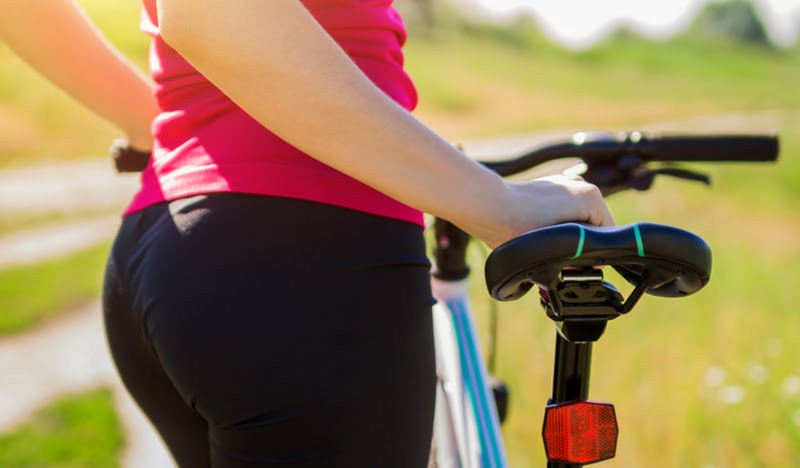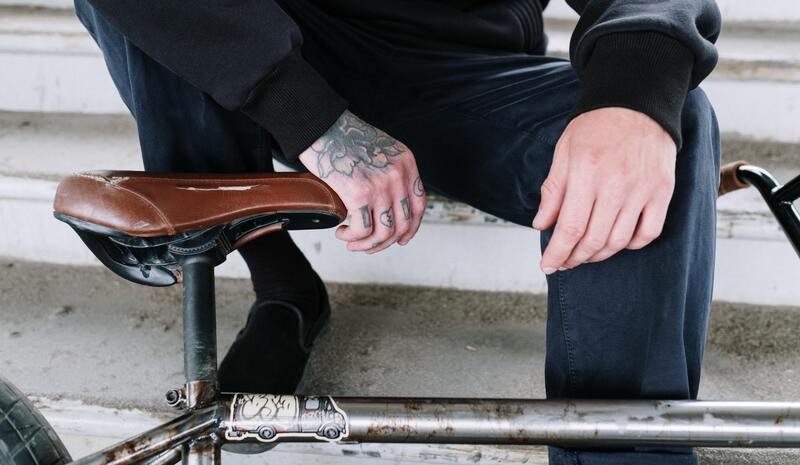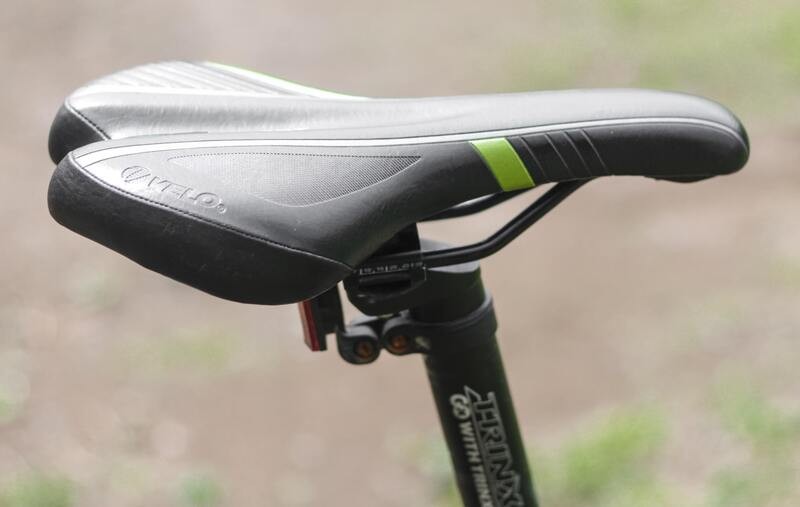A saddle is one of the most important accessories for your bike.
But how to make bike seats more comfortable so that your riding becomes an extraordinary experience instead of an agonizing pain?

Well, it all depends on a wise cycle purchase with which people often make mistakes. Because they think the saddle is just a small part of their bike that is only used to land butts.
And you know what? This is the actual place where they go wrong with their decision-making.
In their ignorance, they don’t realize that a poor saddle can ruin their riding position and can cause sitting bone pain and saddle soreness.
Don’t be scared because this guide will tell you everything you need to know about saddles, from what they are to how they should be fixed.
Are you eager to know? Let’s begin then……
What are Discomfortable Bike Seats

Bicycle saddles, also known as bicycle seats, are one of five contact points on an upright bicycle, along with the pedals and handles on the handlebars. It supports the rider’s buttocks and back and is usually semi-reclined.
As you pedal, pressure from your body weight bears down on the saddle; friction is generated, moisture is rendered from sweat, and the temperature and blood flow are reduced. This can create a perfect storm for discomfort and the formation of sores.
Root Causes of Discomfortable Bicycle Seats
Several factors may contribute to discomfort while riding a bicycle. Among them, the majority of factors are related to discomfort in a sitting position while biking.
For your help, we have listed some of the bigger root causes below. Keep them in mind to make your life better and more comfortable with your cycle.
1. Hard Bike Saddle
Our majority of time on a bike is spent seated, so upgrading your saddle can significantly improve your riding comfort and keep you out longer.
A variety of saddles have been developed to meet the needs of a wide variety of body types, including males and females, different widths of sit bones, hip angles, and weight distribution.
Those seeking marginal gains can benefit from carbon saddle rails but remember to protect them with different seat post clamps. The research, combined with a bit of trial and error, will help you find the right saddle for you.
The Saddle Library feature is made available in some shops to allow riders to try out different saddle options before they purchase them. So, try and invest in a new saddle for a better cycling experience on the road.
2. Saddle Position
Having your saddle set too far back will allow you to produce more power on flats and slight inclines because you will be able to use more energy.
On the other hand, once you start to climb up the road (steep grade), your weight will no longer be able to cover the pedals, and you will have to stand up to climb the hill.
Ultimately, this will lead to a feeling of discomfort as a result. However, a saddle can be positioned correctly by adjusting its height and angle, which is discussed in detail in the next section of the article.
3. Handlebars
It doesn’t matter whether you use flat bars or drop bars; if your handlebar height/reach is incorrect, your weight may be unevenly distributed.
The handlebar tape can play an important role in keeping you comfortable and in control while riding your bike, as it is the main point of contact between you and your bike.
When choosing bar tape, shock absorption, and cushioning are usually the top priorities, as they will have the greatest impact on keeping your hands comfortable.
A material’s choice can also affect a rider’s grip, as well as durability when riding in the wet.
4. Bike Frame Geometry
Geometry determines how a bike handles, how you position yourself on it, and how comfortable you are in that position.
On one extreme, there are bikes designed specifically for racing. The geometry of these bikes usually gives you a more responsive ride with more edgy handling.
As a result, your back will be flattened, and your hips will be bent more, making the ride position longer and lower too.
Alternatively, endurance bikes are also available. Generally, their geometry promotes more upright riding positions and stable, predictable handling.
Therefore, choose a bike that meets your riding needs and seating comfortability because these factors ultimately make you a pro at riding.
5. Bike Fitting
Cycling with a bike that doesn’t fit your body can lead to a variety of pains, such as knee pain. This is the most common overuse injury that cyclists suffer.
It is inevitable that your knees will suffer from additional stress if you continually ride a bike that’s not properly fitted to your body – especially if the saddle position and cleat set-up are not correct. So, kindly prioritize bike fitting before purchase.
6. Discomfortable Clothes
When riders wear the right cycling clothes, they will save energy on long cycling trips. Besides making cyclists go faster, it gives them an attractive look to match their cycling style.
When you wear good cycling clothes, you’ll also stay dry and cool for as long as you ride, no matter how hot it is outside.
Clothing also plays an important role in providing comfortable seating. Padded shorts make it easier for you to grip the saddle, enhancing your riding experience.
10 Realistic Tips to Make Bike Seats more comfortable
Listed below are the only tips you need to make your bike seats more comfortable. So, common let’s analyze each of them one by one.
1. Invest in the Best Bicycle Saddle
Choosing a product that bears your body weight through your sit bones rather than through the soft tissues surrounding them is essential.
In the event of a bike saddle that is too thin or too narrow, your body weight will be poorly distributed. In contrast, saddles that are too wide can cause friction in crotches.

Consider a saddle that places you in an aerodynamic position. Plus, it should have a groove in the center that distributes weight evenly on your sit bones and padding at the back.
Additionally, the midline channel allows air to pass through the seat, preventing sweating in the nether regions.
2. Fine-Tune Saddle Height
An excessively high saddle can cause the hips to rock back and forth. It not only reduces pedaling efficiency but is also highly uncomfortable.
A too-low saddle can also cause problems. You may notice discomfort in your lower back or in the back of your knees.
The inseam is a useful measurement to help you determine your ideal saddle height. A seat height of 109% of your inseam is an ideal height. So, adjust your saddle accordingly.
3. Set the Right Saddle Angle
Most cyclists do not realize the importance of having the correct saddle angle. Bicyclists often experience lower back pain caused by an incorrect saddle angle.
Generally, your saddle should be at an angle between 0 degrees (horizontal) and 4 degrees nose down. There is a great deal of difference in 1 degree. The optimal saddle angle varies from person to person and also depends on the type of saddle.
Place the saddle strictly horizontally, then take a one-hour test ride to determine the ideal angle for your bike saddle.
Lower the front by one degree on your next test ride to make your saddle more comfortable. Keep repeating this until your saddle angle is perfect.
4. Fix Handlebar Height
It’s generally best to keep your handlebars about as high as the saddle unless you’re a sporty rider who wants to ride fast. Try putting your elbow on the saddle nose and reaching forward with your hand towards the handlebar.
Your fingertips should be between two and four fingers’ width apart from the stem’s clamp on a bike that fits you. Handlebar height can be adjusted by moving the stem up and down on the steerer tube.
5. Check your Reach Height
Your upper arm should be bent 90 degrees from your torso; straight arms are a surefire recipe for discomfort and injury.
Have someone check that your back is at about a 45-degree angle to your top tube. For those who are flexible racers, going low and long might work, but for others who simply want a comfy position, aero isn’t everything.
6. Maintain Correct Posture
Maintaining proper posture by equally distributing weight on your bumps and pedals is vital. This dramatically enhances saddle comfort. Start by coming in an upright riding position from your head down to your feet.
Be sure to check in periodically with your body position on long rides to ensure you have not relapsed into old bad habits.
A relaxed, bent elbow acts as suspension, just like on a mountain bike. Keep your hips and shoulders in a reasonably straight line, with your back is relaxed.
Ensure your knee tracks over the ball of your foot/pedal. Align yourself this way, and you’re good to go.
7. Wear Cycling Shorts
Padded cycling shorts protect and cushion the body’s bottom and genitals from saddle pressure and cushion the sit bones. The pad – also called a chamois – cushions your body against the bike saddle by sitting against the crotch.
Chamois pads are typically made of foam, gel padding, and a soft fabric cover that is antimicrobial.
Depending on the need, the pad’s thickness will vary to provide more support in some areas and less bulk in others. Based on your riding style and preferences, you can also find different densities and thicknesses of pads.
8. Try Comfortable Bike Seat Covers
Bike seat covers give your bike more flair or padding, making it more customized to your tastes and needs.
Commuter bikes, beach cruisers, and stationary bikes, which may receive more sunlight than your high-end mountain or road bikes, also benefit from saddle covers. It’s a good thing that most bike seat cushions or covers are not pricey and are available for a variety of bikes.
Note: Always judge bike seat covers on the basis of their materials, durability, and versatility.
9. Go for a Personalized Seat
Saddles are best used according to their shape. While wider saddles are generally considered to be more comfortable, they can put unnecessary pressure on the sit bones and cause saddle sores.
On the other hand, a narrow seat is best for short efforts such as racing, where comfort isn’t completely neglected but is sacrificed a little for other factors. Therefore, when choosing a saddle, you need to take care too wide saddles can chafe, while too narrow saddles can cause a lot of pain.
Measuring your sit bones (the bones at the bottom of your pelvis) is an easy way to figure out what size saddle you will need. These bones carry most of the weight. Using this method, you can figure out what width you need.
10. Avoid Thicker Padding Seats
A comfortable seat is determined by padding on the saddle, which evenly distributes your weight. Racers use a performance saddle with thin padding to save weight and improve comfort. Saddles with thick memory foam or gel padding are used to ensure a comfortable ride.
However, this extra padding can pressurize your sit bones and cut off your circulation if you ride for extended periods. As a result, it is imperative to find saddles with the appropriate amount of padding if you want to ride comfortably.
How to add comfort to Mountain Bike Seat
People often complain about their mountain bikes not being comfortable to ride. Considering that these bikes are already ridden on rough and uncomfortable surfaces, they should be more comfortable.
Usually, it isn’t your bike’s fault but your saddle’s angle and positioning that need adjusting. A lack of cushioning between your hip bone and saddle can also cause discomfort in some cases.
Fortunately, these problems can be solved with the pro tips mentioned above. Therefore, please consider implementing them for better riding on mountain bikes next time.
Conclusion — Riding Comfort
We spend most of our time sitting on a saddle while riding our bikes, which is an essential part of our cycling experience. However, if it is not chosen wisely, a problem arises with its comfort.
Nonetheless, you have a solid understanding of all saddle-related issues by now. Moreover, you are also able to solve them quickly. So, implement the above-mentioned tips whenever you encounter any problem related to a saddle in your life.
Else, if you have any suggestions or doubts, feel free to drop us a comment below. I will be more than happy to assist you with your query. Please like, share, and follow our Facebook Page for more guides like this.
Bike Seat Hurt — FAQs
Why does my bike seat hurt so much?
It’s caused by fabric in your clothing and saddles rubbing together. We know this is annoying, but some products like cushion shorts or chamois cream help prevent the chafing that happens as quickly as possible in your thighs.
How is ride comfort tested?
A vehicle’s VM chassis cm represents the velocity of its mass center. Simulation tests are conducted using torsion-elimination suspension and original vehicles traveling at 10, 30, 40, and 60 kph speeds.
What affects ride comfort?
The stiffness of suspension elements (springs, shock absorbers, antiroll bars, and bushings) is a significant factor in ride quality. A further aspect of suspension structure includes vehicle weight distribution.
What are ride and handling?
Ridership and handling are general terms describing how vehicles react in a vehicle’s driving mode. Aside from that, they also tell how comfortable riders are on the bike.
Related:
